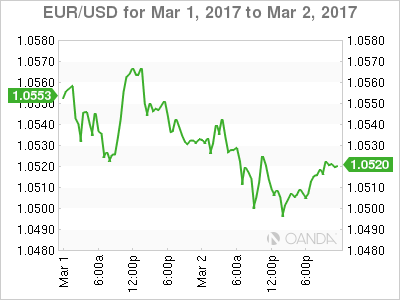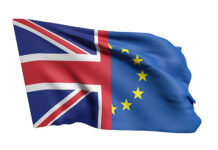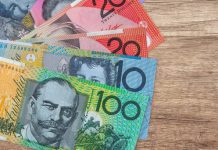Thursday March 16: Five things the markets are talking about
As expected, the Fed raised rates by +25bps, but the outlook of the accompanying statement and Fed Chair Yellen’s press conference was very much less ‘hawkish’ than anticipated.
Absent from the statement was any language indicating an acceleration of interest rate hikes. Market forecast for this year remains at +1.375%, which implies only two more rate hikes in 2017, reversing hints of markets anticipating a potential fourth hike.
Note: The 2018 median forecast was also left unchanged with three more hikes, as the Fed judged near-term outlook as "roughly balanced" and market-based inflation compensation remaining low.
The committee stated inflation was close to their +2% target, but that it was "symmetrical," meaning there may be a willingness to let prices run higher slightly faster.
In reality, the Fed’s outlook has not changed much since December; it’s the market that needs to adjust to the Fed’s rate hike expectations, by again selling the dollar, buying treasuries and stocks.
Investors will now turn their attention to President Trump’s fiscal 2018 budget request to congress today – he is proposing deep cuts to most federal agencies to boost defense and security spending.
1. Global equities given the green light
The Fed’s move to raise interest rates without accelerating the timeline for future tightening has sent global stocks higher.
In Japan, stocks eked out small gains in choppy trade. The Nikkei rose +0.1%, after trading mostly in negative territory on the back of a stronger yen (¥113.43). Investors ignored the BoJ’s no rate policy change (see below).
In Hong Kong, the Hang Seng Index closed at a 19-month high on the Fed ‘slow but steady’ rate view. Trading up +2.1%, its highest close since Aug. 2015.
In China, the Shanghai Composite Index closed up +0.8%, a three-month high, thanks to sharp gains led by brokerage, manufacturing and banking stocks. Investors seized on the Fed’s perceived good news, and chose to ignore the People’s Bank of China (PBoC) increase in money-market rates (see below).
In Europe, equity indices are trading sharply higher. Investors are waiting for the BoE monetary policy decision and post-decision comments scheduled in a couple of hours. Banking stocks leading the gains on the Eurostoxx, while energy, commodity and mining stocks are trading notably higher in the FTSE 100.
U.S stocks are set to open in the black (+0.2%).
Indices: Stoxx50 +1.1% at 3,447, FTSE +1.0% at 7,439, DAX +1.0% at 12,134, CAC-40 +0.8% at 5,025, IBEX-35 +1.6% at 10,142, FTSE MIB +1.6% at 20,085, SMI -0.3% at 8,666, S&P 500 Futures +0.2%

2. Oil prices extend gains after drop in U.S. stockpiles
Crude oil prices have extended its gains overnight after data yesterday showed U.S. stockpiles had eased from their record highs.
Brent futures have climbed +47c, or +0.9% to +$52.28 – They had their first increase in seven days yesterday, gaining +1.7%. West Texas Intermediate (WTI) crude is up +39c, or +0.8%, at +$49.25 a barrel. On Wednesday, it rallied +2.4%, its first increase in eight-days.
Data from the EIA yesterday showed U.S stocks falling last week, the first weekly decline after nine straight increases. Crude inventories fell -237k barrels in the week to March 10 – the market was expecting another increase of +3.7m barrels.
Crude bulls are taking solace in the IEA’s statement that ‘demand should overtake supply in H1 this year’ and in OPEC’s level of compliance with the cuts.
Note: There are early signs that OPEC’s March compliance data will be stronger than the previous two-months.
Ahead of the U.S open, gold (+0.6% to +$1,226.21 per ounce) has hit a one-week high after the Fed signaled a cautious stance on interest rate policy this year, pushing the dollar to its lowest level in a month.

3. Central Banks being kept busy
Overnight, the People’s Bank of China (PBoC) also eased off the monetary accommodation in the wake of the Fed’s decision, raising rates it charges in open-market operations and on its medium-term lending facility. It’s not a shift in policy, but rather reflect changes in markets, firmer domestic economy, and strong credit expansion. The PBoC also strengthened the Yuan in its daily fix by the biggest margin in two-months.
In Japan, the Bank of Japan (BoJ) maintained its policy stance with more upbeat view of longer-run inflation. Officials, as expected, left interest rates (IOER) unchanged at -0.10% and has maintained its 10-yr JGB yield target around +0%. The BoJ has also kept its JGB buying target at about +¥80T per year, while maintaining its overall assessment of their economy to continue its moderate recovery trend.
Earlier this morning, there were no surprises from the Swiss National Bank (SNB) who left their deposit rate at -0.75% and repeated its long-held view that the CHF ($0.9994) is "significantly overvalued."
The Bank of England (BoE) is up next (08:00aam EST) and no changes are expected to monetary policy.
The yield on U.S 10’s has backed up +3bps to +2.52% after tumbling -11bps yesterday. Similarly, Aussie yields have fallen -10bps to +2.82% and Kiwi -10bps to +3.26%.

4. Dollar sees red, but the bleeding is slowing
The mighty USD is weaker across the board, particularly against JPY as it fell as much as -140 pips to below the psychological ¥113 handle (¥112.90). Investors remain somewhat cautious ahead of this weekends G20 meeting. What will U.S say about China’s yuan policy? Ahead of the U.S session its trading atop of ¥113.40.
The EUR has rallied to above €1.0720, helped by a weaker showing for the Eurosceptic party in the Dutch elections (see below).
Sterling (£1.2269) will take its cues from the Bank of England (BoE) later this morning.

5. Dutch populist vote easily beaten
The Dutch political establishment held on to power, despite losing votes to anti-immigrant nationalists. Prime Minister Rutte’s center-right People’s Party for Freedom and Democracy gained the most votes, putting him in a strong position to form a new ruling coalition.
The VVD has won 33 seats, eight fewer than in 2012, while the far-right populist Party for Freedom of Wilders is second with 20 seats, five more than the last time but still a stinging setback for Euro populist vote. They will now start a long process of coalition talks.












